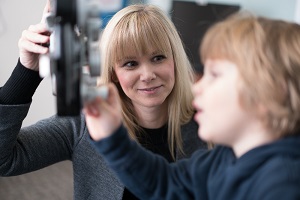
To restore vision and eliminate the need for very strong eyeglasses, doctors can perform surgery to attach a prosthetic lens to the wall of the eye. But getting the lens to stay put is easier said than done: a child’s eyes are still growing, and their eye tissue is different than an adult’s. Now, new research from the John A. Moran Eye Center—one of just a few centers nationwide to provide pediatric lens surgery—is identifying surgical techniques that provide the best long-term outcomes for kids.
Specialist Leah Owen, MD, PhD, and colleagues Alan S. Crandall, MD; Marielle Young, MD; and Julia Byrd, MD, recently analyzed procedures that used a capsular tension device to attach a prosthetic lens in children with conditions such as ectopia lentis syndrome and Marfan’s syndrome. Both cause spontaneous, rather than traumatic, lens dislocation.
While various advanced surgical techniques have improved patient outcomes in recent years, data on the long-term effects, safety, and stability of these techniques in children is limited. The Moran group conducted a retrospective analysis of 37 ectopia lentis pediatric patients, average age 6.9 years, who had surgery at Moran between January 2006 and January 2016.
Their research, "Long-Term Outcomes of Scleral Sutured Capsular Tension Device in Pediatric Ectopia Lentis" published in the Journal of Cataract and Refractive Surgery in May 2018, showed children had significantly improved vision and a very low rate of complications or lens detachment from the eye wall up to 10 years after surgery.
To date, this research analyzed the greatest number of eyes and has the longest follow-up of any study of its kind. The hope, said Owen, is that "this work will continue to innovate and improve vision for children suffering with ectopia lentis."
The study was supported by National Institutes of Health, the Eunice Kennedy Shriver National Institute of Child Health & Human Development, and an unrestricted grant from Research to Prevent Blindness.